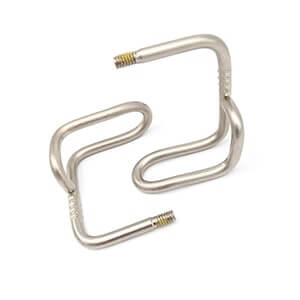Get unique, complex parts easily. No matter your requirements, Chaoyi Spring creates hard-to-produce coil springs and wire forms.
Let us help you create the custom wire form you need, from S-hooks and J-hooks to utility hooks and more.
We work closely with customers across a wide range of industries, helping them design and manufacture made-to-order parts.
Why choose Chaoyi Spring? We prioritize customer-focused collaboration, modern equipment and the latest technology to make your parts per print.
Find the information and guidance you need, from measuring a spring to learning about materials, placing an order and much more.
Imagine a world without compression springs. No bouncy car rides, no smooth-closing doors, no clicky pens. It's a world that would feel a little...off, right? Compression springs, those ubiquitous coiled


Imagine a world without compression springs. No bouncy car rides, no smooth-closing doors, no clicky pens. It's a world that would feel a little...off, right? Compression springs, those ubiquitous coiled metal wonders, are the unseen workhorses of countless everyday objects. They are the backbone of countless devices and systems, quietly working behind the scenes to make our lives easier, safer, and more enjoyable. From the simple act of pushing a button to the complex engineering of a suspension system, compression springs are everywhere, performing their duty with remarkable reliability.

Compression springs, as their name suggests, are designed to resist compression or pushing forces. These springs are made by coiling a wire around a cylindrical core, creating a series of closely spaced coils. When a force is applied to the spring, it compresses, storing potential energy within the coils. As the force is removed, the spring returns to its original shape, releasing the stored energy. This spring action is the basis for countless applications in various industries.
The behavior of compression springs is governed by Hooke's Law, a fundamental principle of physics. This law states that the force exerted by a spring is directly proportional to its displacement from its equilibrium position. The constant of proportionality is known as the spring constant (k), which is a measure of the spring's stiffness. A higher spring constant indicates a stiffer spring, requiring more force to compress it.
The spring constant (k) of a compression spring can be calculated using the following formula:
k = (Gd^4) / (8D^3n)
Where:
- G is the shear modulus of the spring material
- d is the wire diameter
- D is the mean coil diameter
- n is the number of active coils
Compression springs come in a wide variety of shapes, sizes, and materials, each designed for specific applications. Here are some common types:
These are the most common type of compression springs. They are simply helical coils of wire with a defined spring constant.
These springs have a spring rate that varies throughout their compression cycle. This is achieved by using different coil diameters or varying the spacing between the coils.
These springs provide a constant force over their entire compression range. This is achieved by using a special winding technique.
While not strictly compression springs, torsion springs are closely related. They are designed to resist twisting forces, often used in applications like door hinges and spring-loaded mechanisms.
Compression springs are truly ubiquitous, finding their way into a vast range of applications across various industries. Here are some examples:
Compression springs are crucial components of automotive suspension systems. They absorb shocks and vibrations from the road, ensuring a comfortable ride and maintaining vehicle stability.
Compression springs are used in various aircraft components, including landing gear, flaps, and control systems. Their ability to withstand high stresses and extreme temperatures makes them ideal for aerospace applications.
Compression springs are integral to countless consumer products, from pens and pencils to door closers and furniture mechanisms. They provide the spring action that makes these everyday objects work as they should.
Compression springs are found in a variety of medical devices, including surgical instruments, catheters, and prosthetic limbs. Their biocompatibility and precise force characteristics make them suitable for use in sensitive medical applications.
Compression springs are vital components in industrial machinery and equipment, such as presses, clamps, and conveyors. They provide the force needed to operate these machines efficiently and safely.
Selecting the right compression spring for a particular application requires careful consideration of several factors, including:
- Spring constant (k): This determines the stiffness of the spring.
- Maximum load: The spring must be able to withstand the maximum force applied to it.
- Compression length: The amount the spring can be compressed without exceeding its limits.
- Material: The choice of material depends on the specific application and its environmental conditions.
- Durability: The spring needs to be durable enough to withstand repeated cycles of compression and release.
Compression springs continue to evolve, with advancements in materials and manufacturing processes pushing the boundaries of what's possible. New spring designs are emerging, offering increased performance, durability, and efficiency. From the humble coil spring to more complex designs like variable stiffness springs, the future holds exciting possibilities for these versatile components.
Compression springs may not be the most glamorous components, but they are undeniably essential. They are the silent heroes of our everyday lives, ensuring that countless devices and systems function reliably and smoothly. Whether we realize it or not, compression springs are constantly at work, making our world a little bit better, one spring action at a time. As technology continues to advance, we can expect to see even more innovative applications of compression springs, further solidifying their position as indispensable components in our modern world.
Browse some of the custom wire forms and springs that we manufacture. Don’t see what you need? We specialize in made-to-order products that meet your application requirements.
Visit Our GalleryNeed a custom wire form or coil spring? We make it work. Fill out the contact form and a representative will respond within 1 business day. If you have a PDF or CAD file, you can submit to request a quote.